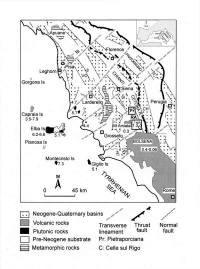|
Sedimentary Geology, 183 (2005), 71¨C97.
ˇˇ
TECTONO-SEDIMENTARY ANALYSIS OF A
COMPLEX, EXTENSIONAL, NEOGENE BASIN FORMED ON THRUST-FAULTED, NORTHERN APENNINES
HINTERLAND: RADICOFANI BASIN, ITALY
ˇˇ
V.
Pascucci1, A.
Costantini2, I.P.
Martini3 and R. Dringoli2
ˇˇ
1Istituto
di Scienze Geologico-Mineralogiche, Universit¨¤ di Sassari, Corso Angioy 10,
07100 Sassari, Italy
2Dipartimento
di Scienze della Terra, Universit¨˘ di Siena, Via Laterina 8, 53100 Siena, Italy
3Department
of Land Resource Science, University of Guelph, Guelph, Ontario, N1G 2W1, Canada
ˇˇ
ˇˇ
Large
NW-SE oriented, Neogene-Quaternary structural depressions, up to about 200 km
long and 25 km wide, have developed on the western side (hinterland) of the
Northern Apennines over thrust substrate. The depressions are now, for the most
part, laterally bounded by normal faults and are longitudin ally
separated into basins by transfer zones. A debate exists in the literature as to
whether these basins have developed as half-graben under a predominantly
extensional regime since late Miocene, or as thrust-top basins under a
predominantly compressional regime that has continued until the Pleistocene. The
Radicofani Basin is one of the best-preserved basins. It developed mainly during
the late Miocene-early Pliocene in the southern half of the Siena-Radicofani
structural depression,
and is now bounded on the east by normal
faults that transect a thrusted anticline ˇ°noseˇ° in the substrate, to the north
by a substrate high or transfer zone, and to the south and west by Quaternary
igneous/volcanic edifices. The basin experienced variable differential tectonic
and associated sedimentation along linking, normal boundary faults. Along its
eastern margin it shows the development of thick (~ 600 m) alluvial fans are
developed in relay areas between boundary faults and transverse faults and
transfer zones. Well-exposed sections generally show upward transitions from
conglomeratic alluvial fans, to shoreface sandstone, to offshore mudstones.
Locally, the transition is marked by deltas primarily characterised by thick
gravelly, sandy, stacked cross-sets The thicker, sandy-gravel to gravelly-sand
cross-sets (5-8 m thick) are interpreted as Gilbert-type deltas; interstratified
thinner (0.5-1 m thick), generally openwork gravelly strata are part of delta
topset assemblages and probably represent prograding fluvial bars. Tectonic
movements provided the accommodation space for the total, ~ 2700 m thick basin
fill. Sea level fluctuations that led to the repeated development of the
cross-sets may also have been influenced by climatic or eustatic changes,
possibly related to the effects of early Antarctic glaciations. ally
separated into basins by transfer zones. A debate exists in the literature as to
whether these basins have developed as half-graben under a predominantly
extensional regime since late Miocene, or as thrust-top basins under a
predominantly compressional regime that has continued until the Pleistocene. The
Radicofani Basin is one of the best-preserved basins. It developed mainly during
the late Miocene-early Pliocene in the southern half of the Siena-Radicofani
structural depression,
and is now bounded on the east by normal
faults that transect a thrusted anticline ˇ°noseˇ° in the substrate, to the north
by a substrate high or transfer zone, and to the south and west by Quaternary
igneous/volcanic edifices. The basin experienced variable differential tectonic
and associated sedimentation along linking, normal boundary faults. Along its
eastern margin it shows the development of thick (~ 600 m) alluvial fans are
developed in relay areas between boundary faults and transverse faults and
transfer zones. Well-exposed sections generally show upward transitions from
conglomeratic alluvial fans, to shoreface sandstone, to offshore mudstones.
Locally, the transition is marked by deltas primarily characterised by thick
gravelly, sandy, stacked cross-sets The thicker, sandy-gravel to gravelly-sand
cross-sets (5-8 m thick) are interpreted as Gilbert-type deltas; interstratified
thinner (0.5-1 m thick), generally openwork gravelly strata are part of delta
topset assemblages and probably represent prograding fluvial bars. Tectonic
movements provided the accommodation space for the total, ~ 2700 m thick basin
fill. Sea level fluctuations that led to the repeated development of the
cross-sets may also have been influenced by climatic or eustatic changes,
possibly related to the effects of early Antarctic glaciations.
Some features of the Radicofani Basin can be found in
both extensional and compressional basins. However, the position of the basin in
the mountain chain and the development alluvial fans, fandeltas and associated
deposits along the main boundary fault, combined with structural evidence from
seismic lines, show that during the early Pliocene this basin best conforms to
existing models of half-graben.
ˇˇ
|